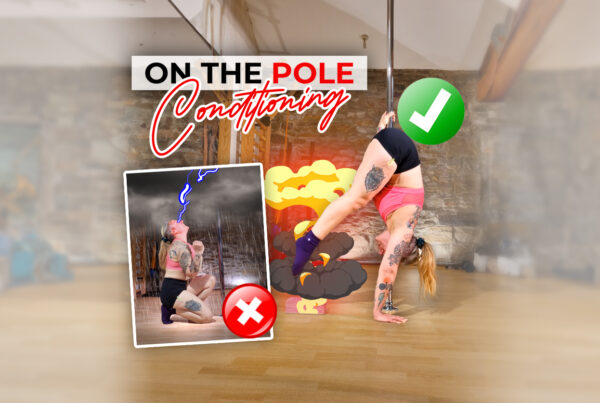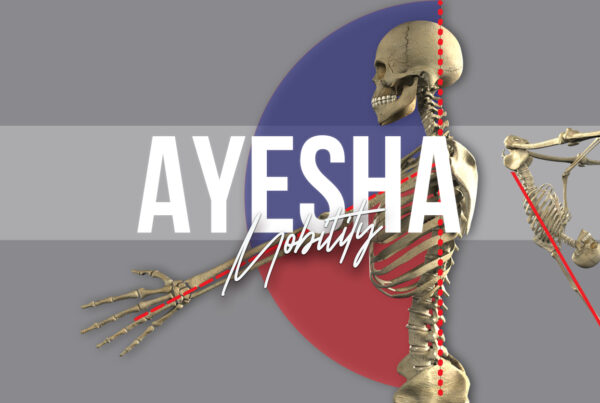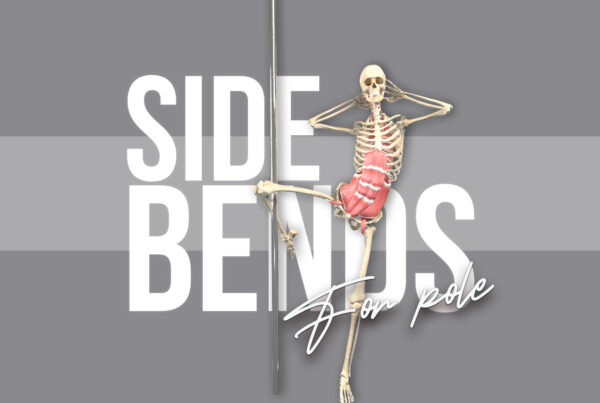Got your invert (yay!) and wondering how to progress to your shoulder mount?
Let’s nerd it out!
On paper, the ‘basic’ pole invert and shoulder mount actually have a lot in common!
In both, we need strength in our hip flexors and core to lift our legs in the air and move into a posterior pelvic tuck.

In both movements, we also need a lot of upper body pulling strength, especially from our lats.

The muscles of our mid back, particularly our traps, rhomboids and erector spinae are also working hard in both the invert and shoulder mount to resist excessive scapular protraction and excessive rounding of our spine.

Of course, those aren’t the only muscles involved! I’ve barely even mentioned the lower body there – and you just know I’m gonna cover some more of the finer details below!
But my point is: we’re using the same key muscle groups for both our invert and our shoulder mount, so what is it that makes shoulder mounts so much harder than inverts? And how can we use that nerdy knowledge to help us train more effectively for our shoulder mount?
If you’d rather watch than read – check out the quick run-through video below!
As always, if you want alllll the nerdy deets, keep on scrollin’
Pole invert vs shoulder mount – a look at the key differences!
The good news is that having the strength to invert is the perfect foundation on which to build shoulder mount strength. All the main ingredients are already there, but most people will find the shoulder mount more challenging for a number of reasons.
Understanding the key differences between invert and shoulder mount provides us with so many clues. If we make like Scooby Doo and follow those clues, we can solve the mystery of shoulder mount strength and use them to direct our training *exactly* where we need it to bridge that gap and progress from invert to shoulder mount.
So let’s take a look at the main differences…
#1 Longer levers
We have to move our bodyweight further away from our base of support in the shoulder mount, so although we may be using the same muscles we’ve trained for our invert, that extra challenge of having our centre of mass further away from the pole means those muscles are having to work EVEN harder in the shoulder mount!

#2 Bigger range of motion
We’re usually working through a bigger range of motion in our shoulder mount.
In our invert, because of our hand position, although we ARE using our lats to keep our body lifted, the distance between our arms and torso doesn’t usually change that dramatically through the movement compared to the shoulder mount…

Whereas in the shoulder mount, our lats have to work a lot harder to close that gap and lift our body up to meet our arms.

Notice, too, that the direction of the pull is a little different (in relation to our body). In the shoulder mount, we’re pulling vertically (from above), whereas in the invert although the initial pull is vertical, as our torso lifts the pull becomes more horizontal.
Our spine is usually starting from a more extended position in the shoulder mount too (especially if we’re performing an aerial shoulder mount), so our core muscles also have to work harder to bring our spine through that bigger range from extended to flexed.

#3 The arm engagement is different
Here’s where the range of motion is actually bigger in our invert! Our biceps and triceps are involved in both invert and shoulder mount, but in the shoulder mount those muscles are contracting more isometrically (i.e we’re holding the bent arm position as we lift).
If we could test the muscle activation involved, I’d guess that our triceps are probably working hardest in the shoulder mount to assist in the pull and to create tension on the pole against our shoulder, whereas in the invert, our biceps are working more eccentrically (i.e. our biceps are lengthening) as we control the straightening of our arms in the tip back.

#4 Stability from the pole
We have more skin contact with the pole in our invert. That extra contact on the inside of our arm and the side of our torso in the invert can gives us a little extra stability and sensory feedback, compared to the shoulder mount where we’re levering up from the pivot point of our shoulder.

This reduced skin contact means it’s not just the ‘key’ muscle groups that are being challenged more in the shoulder mount – all the stabilising muscles that support the movement have to work much harder, too!
Having said that, unlike the invert, the shoulder mount really harnesses the stability of the pole, by creating tension against it. Although this might sound wild if you’re currently struggling with your shoulder mount, many people eventually find the shoulder mount more stable than the invert, if they feel strong in creating that tension and using that stability to their advantage!
#5 A more challenging grip point
The fact that the pole is behind us rather than in front of us – and that we usually spend a lot of time even as baby pole dancers building up to the invert and conditioning the invert grip adds an additional proprioceptive learning curve when it comes to starting the process of learning the shoulder mount.
The skin grip point on the trap muscle can be painful when we first start learning the shoulder mount grip, too. It can take a little extra patience and gradual progression to find that ‘sweet spot’ for our shoulder mount position and to feel comfortable there, before we even start working on the actual lift!
So, how can we apply this to our shoulder mount training?
The reason I LOVE looking at the movements of pole in such detail like this ^ is that understanding the exact challenges of a movement allows us to train very specifically to overcome those hurdles and progress more directly towards our goal.
If you’ve already got your invert, focusing your strength progressions on the more challenging elements and key differences we’ve covered above is a good way to really hone in on the extra strength you’ll need for the shoulder mount.
We can use this info to guide exercise selection for our shoulder mount mission, to ensure we’re spending our precious training time exactly where we need it. In particular, I’d say the take-homes are:
- Whereas isometric lat strength and horizontal pulling has a lot of transfer to our invert, for our shoulder mount it’s probably more helpful to work on lat strength through a bigger range of motion and with a focus on vertical pulling (moving from overhead).
- Whereas eccentric bicep strength is important for the invert, tricep strength (particularly isometric) may be more useful for our shoulder mount.
- Working on the core strength to bring our body from that more extended spinal position into the flexed position can be particularly useful for our shoulder mount training.
- ‘On the pole’ exercises that help us understand the more challenging grip, engagement and stability demands of the shoulder mount will be super useful too!
2 exercises for shoulder mount strength
So, with all that in mind, I’ve chosen two key exercises for the shoulder mount – one on the pole and one in the gym – which demonstrate how we can hit some of these key areas, both on and off the pole.
Exercise #1 – Cable pull overs
This exercise is focused on pulling strength, working from that slight overhead position for the pull, just like we do in our shoulder mount.
No cable machine? You can do this with a resistance band, too!
Exercise #2 – Stability ball shoulder mount progression
I LOVE stability ball progressions for the shoulder mount!
There are so many different variations! Altering how you position your body on the ball and how vertical vs horizontal you are will allow you to work on different elements of the shoulder mount, so you can adjust the positioning depending where you need to build strength the most.
The version I’m demoing in the video below focuses on that part of the movement where we move from a slightly extended spinal position into spinal flexion. Your exact position will depend a lot on the size of your ball, so don’t be afraid to play around and find the sweet spot that allows you to work through that range!
It’s important to avoid any ‘pole on bone’ action with your shoulder mount grip. You shouldn’t be making contact with your collarbone and the pole as you lift. It can take a little time to find the right sweet spot and your exact position may look different to mine, but I’d recommend starting with the pole more on your back (rather than right on top of your shoulder). It should end up on the squishy part of your upper trap muscle as you lift!
If you’ve got your invert (you’re awesome btw!) and are starting to build towards your shoulder mount (heck yeah, we love a challenge!), I hope this post helped get you thinking about how to progress your ‘on’ and ‘off the pole’ strength and conditioning work. Do you know which of the key areas above you might need to work on most to give your progress a boost?
Want a little more structure for your shoulder mount mission? My 6-week shoulder mount training programme is now available as a downloadable, interactive workbook! It contains videos of all my shoulder mount exercises and progressions, structured into a 6-week training programme that you can start today! Let’s get it!
SHOULDER MOUNT TRAINING WORKBOOK
Content on this website is provided for educational/informational purposes only. It is not a substitute for professional medical advice. You should consult your Doctor or Health Care Professional before doing any exercises or fitness programs to determine if they are right for your needs.






